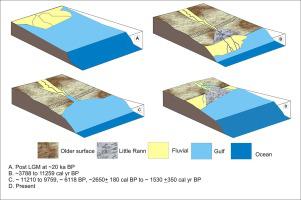Journal of Asian Earth Sciences ( IF 2.7 ) Pub Date : 2021-04-20 , DOI: 10.1016/j.jseaes.2021.104777 Rachna Raj , Jayant K. Tripathi , Pankaj Kumar , Saurabh K. Singh , Binita Phartiyal , Anupam Sharma , Alpa Sridhar , Laxman Singh Chamyal

|
A sediment core from a palaeochannel distributary of the Saraswati River basin in western India was investigated through a multi-proxy study using palynology, phytoliths, sedimentology, geochemistry, magnetic mineralogy and chronology. The site is located at the eastern margin of the Little Rann of Kachchh in the northwestern part of the Gujarat Alluvial Plains. The goal was to reconstruct the paleoclimatic and sea level flucutations spanning from the last deglaciation to the late Holocene in the area.
The core records suggest at least four episodes of marginal marine environment between the last deglaciation and the late Holocene. The first phase of sediment deposition under marine influence was observed post LGM at ~20 ka BP. The signatures of coeval dry climatic conditions of Older Dryas and Younger Dryas periods besides warm and humid conditions of Bølling-Ållerød period are reflected in the core records. The second phase of rise in sea level occurred between ~11,210 and ~9795 cal yr BP, which falls within the period of high gradient of sea-level rise of western India. The third phase of global sea level rise in the area is at around ~5747 cal yr BP which coincides with a high sea level phase along the west coast of India. The final recurrence of sediments with predominant marine signatures post ~2650 ± 180 cal yr BP until ~1530 ± 350 cal yr BP suggests marine to marginal marine conditions in the area.
中文翻译:

印度西部从上一次冰消期到晚全新世的古气候和海平面波动:多代理研究的证据
通过古生物学,植物石层学,沉积学,地球化学,磁性矿物学和年代学的多代理研究,对印度西部萨拉斯瓦蒂河流域古河道分水岭的沉积物芯进行了研究。该地点位于古吉拉特河冲积平原西北部的卡奇(Kachchh)小兰恩(Little Rann)东边缘。目的是重建该地区从上一次冰消作用到晚新世的古气候和海平面变化。
核心记录表明,在最后一次冰消和新世晚期之间至少有四次边缘海洋环境。LGM后约20 ka BP观测到受海洋影响的沉积物第一阶段。核心记录中还反映了老德里亚斯和新德里亚斯时期的中世纪干旱气候特征,以及伯灵-奥勒勒德时期的温暖和潮湿条件。海平面上升的第二阶段发生在约11,210到9795 cal yr BP之间,属于印度西部海平面上升的高梯度时期。该地区全球海平面上升的第三阶段约为BP 5747 calyr yr,这恰好与印度西海岸的高海平面阶段相吻合。










































 京公网安备 11010802027423号
京公网安备 11010802027423号